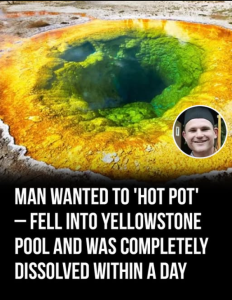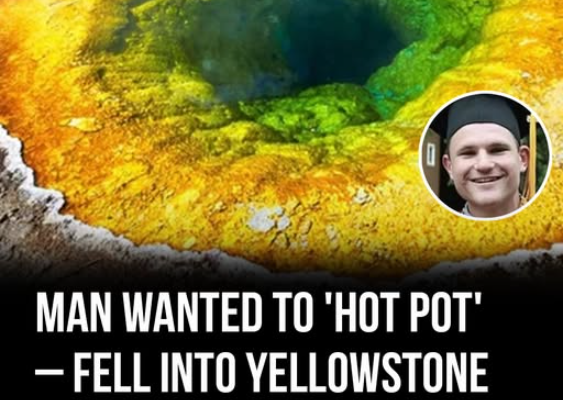Man Suffers Horrific Death After Being ‘Dissolved’ at Yellowstone – A Tragic Reminder of Nature’s Power
Yellowstone National Park — a place famous for its stunning geysers, hot springs, and breathtaking landscapes — is often called one of the most beautiful natural wonders in the world. But beneath its serene surface lies a deadly force that few fully comprehend. What makes this park so captivating is also what makes it incredibly dangerous.
This truth became painfully clear during a shocking and heartbreaking incident in which a man lost his life after accidentally falling into one of Yellowstone’s boiling hot springs — a place where temperatures can soar above 200°F (93°C) and acidic waters can dissolve human flesh and bone in a matter of hours.
This isn’t a ghost story or a myth. It’s a real, documented event that reveals the terrifying power of nature.
A Day of Adventure Turns Deadly
It began like any other visit. A 23-year-old man, visiting the park with his sister, set out to explore one of Yellowstone’s most active and dangerous regions — the Norris Geyser Basin. This area is known for its stunning thermal features, including steaming vents, vibrant pools, and unpredictable geysers.
Warning signs line the walkways, clearly instructing visitors to stay on the boardwalks at all times. The ground in these areas is thin and unstable — what looks like solid earth can in fact be a fragile crust covering boiling acidic water.
But the man reportedly wanted to get a closer look. Witnesses later said he stepped off the designated path, despite the clear warnings. Just moments later, he slipped and fell into a scalding hot spring.
His sister desperately tried to help, but there was nothing she could do. Rangers arrived quickly, but the heat and acidity of the water made it impossible to rescue him in time.
The Deadly Nature of Yellowstone’s Hot Springs
To understand why this incident was so devastating, it helps to understand what makes Yellowstone so unique — and so dangerous.
Beneath the surface of the park lies a massive volcanic system. Its underground magma heats groundwater, creating geysers, hot springs, and fumaroles. But this water isn’t just hot — it’s often boiling and filled with corrosive minerals that can strip away flesh within minutes.
The average temperature in some of these springs exceeds 200°F (93°C), and the water can be highly acidic, with a pH level comparable to battery acid. Even experienced rangers are trained never to enter these areas without extreme protective measures.
Search and Recovery — and the Terrifying Truth
After the man fell in, recovery teams had to wait until the following day to attempt to retrieve his remains, as dangerous thermal activity made it impossible to safely approach the spring immediately.
But when they returned the next morning, they made a horrifying discovery: there was almost nothing left. The hot, acidic waters had dissolved the young man’s body overnight. Only a few personal belongings were recovered from the area.
This gruesome outcome is not unique. Yellowstone’s geothermal pools are so unforgiving that even metal objects can corrode quickly. For a human body, the effect is catastrophic.
Park Officials Issue Stern Warnings
In the aftermath of the incident, Yellowstone officials once again emphasized the importance of following park rules.
“The boardwalks and trails are there for a reason,” one park ranger said at the time. “These thermal features may look calm and beautiful, but they can kill you in seconds.”
Every year, millions of people visit Yellowstone, but incidents like this one are a sobering reminder that nature does not forgive recklessness. Even a single step off the safe path can be fatal.
Not the First — And Not the Last
This tragic case is not the only one of its kind. Over the decades, multiple visitors have lost their lives after ignoring warnings and venturing too close to the park’s geothermal features.
-
In 2016, an Oregon man reportedly fell into a hot spring after attempting to “hot pot” — an illegal practice where people try to soak in the thermal pools. His body was completely dissolved before recovery teams could retrieve him.
-
In 1981, a 24-year-old man fell into a pool at Mammoth Hot Springs and died from third-degree burns over 100% of his body.
-
More recently, in 2022, a visitor at Yellowstone National Park was found dead in another thermal area, underscoring the continuing danger.
Despite strict safety guidelines, accidents — often caused by ignoring warning signs or taking unnecessary risks for photos — continue to happen.
Why the Ground Is So Dangerous
Part of the danger lies in the illusion of safety. The ground near these hot springs often looks solid. It can appear dry, crusty, or covered with grass and dirt. But underneath, there may be only a paper-thin layer of crust separating a person from scalding water.
When someone steps on it, the crust can give way instantly — leaving no time to react. The drop may only be a few feet, but in that short distance lies lethal heat.
Rangers often say that if you break through the crust, the water beneath is hot enough to cause fatal burns in less than a second.
The Science of a Terrifying Death
Falling into a Yellowstone hot spring is not like falling into a regular body of water. At temperatures above 160°F (71°C), skin can suffer third-degree burns almost immediately. At 200°F (93°C) or higher, death can occur in a matter of moments.
Adding to the horror, many springs also contain high concentrations of silica, sulfuric acid, and other corrosive compounds. These substances break down organic matter rapidly.
By morning, the man’s remains had been almost entirely dissolved — a chilling testament to just how powerful these thermal features are.
A Painful Lesson for Visitors
Park rangers say that while most visitors respect the rules, there is still a troubling number who ignore them — stepping off the path to take photos, touch the water, or simply explore. In many cases, they underestimate how dangerous the geothermal areas are.
Unlike many other national parks, Yellowstone isn’t just a scenic destination — it sits atop an active supervolcano. Everything about it demands respect and caution.
This tragedy serves as a brutal reminder that these hot springs are not playgrounds. They are natural phenomena with the power to kill instantly.
How the Park Protects Visitors
National Park Service has implemented a series of strict rules to prevent accidents like this:
-
Visitors must stay on designated boardwalks and trails at all times in thermal areas.
-
Warning signs are placed prominently throughout the park.
-
Rangers conduct regular patrols to prevent dangerous behavior.
-
“No Trespassing” zones are strictly enforced, and fines can be severe.
Still, no amount of warning can fully protect someone who decides to break the rules.
The Power — and Danger — of Natural Beauty
Yellowstone’s hot springs are undeniably beautiful. The rainbow-colored pools, the swirling steam, the bubbling water — all of it creates an otherworldly landscape unlike anywhere else on Earth. But that beauty is built on forces far beyond human control.
This tragic incident is not meant to frighten people away from Yellowstone. It’s meant to remind us that nature must be respected, not underestimated. One careless step can mean the difference between wonder and disaster.
A Final Warning That Should Be Heard
The young man who lost his life didn’t get a second chance. His story stands as a cautionary tale for the millions who will visit Yellowstone in the years to come.
The park’s geysers and hot springs may seem calm, but beneath their surface is a deadly reality: temperatures and acidity that no human body can survive.
In the end, this tragedy is about more than one terrible moment — it’s about the fragile line between beauty and danger in the natural world. Respecting that line isn’t just wise. It’s a matter of life and death.
⚠️ Yellowstone is beautiful. But Yellowstone is deadly. Never step off the boardwalk. Never ignore the warnings. Nature always wins.

